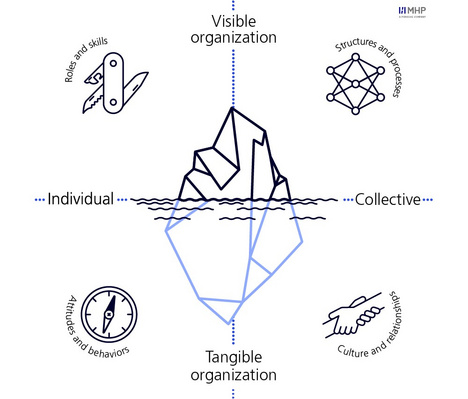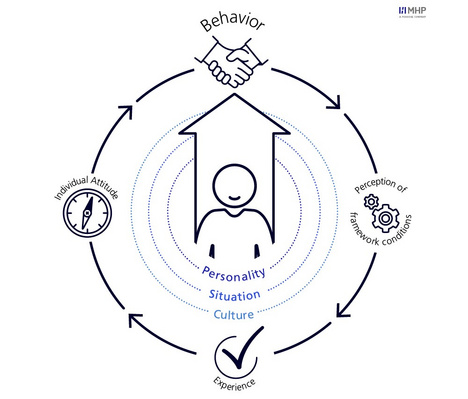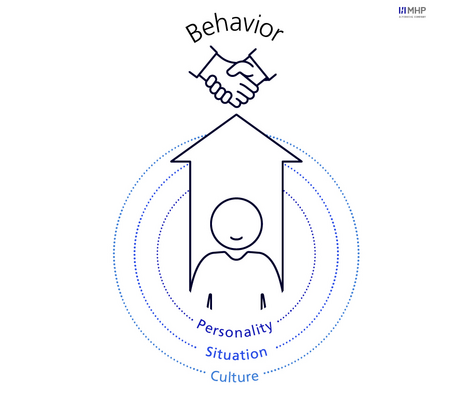
- Blog , Digital Transformation
- Published on: 01.12.2023
- 11:27 mins
Shape the future of your company with cultural change
Discover how company transformations and sustainable communication go hand in hand.
When it comes to corporate sustainability, we tend to think about environmental sustainability and reducing carbon emissions – but sustainability refers to more than just a company’s approach to the climate. It is also about interpersonal relationships and acting in a forward-looking way. These guiding principles are becoming ever more important to companies, and not just because of external expectations. They are also key to making internal processes, such as communication within the company, more sustainable, more efficient, and more productive. However, creating a sustainable culture of communication requires a profound cultural change in organizations.
This article explains how you can successfully shape a cultural transformation in your company and how you can improve communication within your organization over the long term. In addition, our case study will give you a deeper insight into how cultural change can be implemented within a larger company.
What is cultural change in organizations?
A “cultural change” refers to the process of changing and developing a company culture. It concerns a far-reaching transformation of the way that business leaders and employees think, act, and interact with one another. A cultural change can be triggered by internal or external factors. These triggers can include technological developments, digitalization, market changes, societal changes, and new company strategies. Cultural change is also very relevant to other challenges, such as sustainability transformation. After all, changes and innovations only bring value if the workforce adopts these as part of their work.
A cultural change in organizations is about modifying or redefining values, standards, and associated behaviors, as well as codes of conduct and recurring practices. All while doing this at a pace that every stakeholder, from business leaders to trainees, can easily keep up with but where progress is clearly noticeable.
Reshaping company culture from the inside
Previously, people used to think that company culture developed independently or even that it couldn’t be controlled. But it has since become accepted that it requires the management’s active and strategic co-determination. As such, shaping the organizational culture requires the input and work of both business leaders and the workforce.
Culture is just one element of the corporate system. Other elements within a corporate system include:
- Roles and skills
- Structures and processes
- Attitudes and behaviors of individuals
If one of these parts of an organization changes, it leads to changes in the others.
During a period of cultural change in an organization, the company should be analyzed internally (tangible changes) and externally (visible changes), with a focus on both individuals and the group dynamic as a whole.
How do cultural change and sustainable communication in organizations relate to one another?
The increasing importance of sustainability for companies is not just impacting day-to-day business; it also influences communication with the workforce and with customers.
While sustainability in terms of production, product development, compliance, regulatory issues, etc. is often considered, sustainability associated with people tends to play a subordinate role. But sustainability isn’t a business issue; it is a cultural issue:
It is vital to include employees and customers in the process to win their loyalty to the company.
The propensity of these stakeholders to identify with a company is becoming more and more important. In this era of hybrid working, fostering an affinity with the company can help to increase the motivation of the workforce.
While societal discourse on sustainability has a tendency to polarize opinion, companies can help to make sustainability a tangible issue with practical solutions for employees.
Mental health is a key factor in lasting performance and motivation, particularly in these times of increasing digitalization and dynamism.
With this in mind, establishing sustainable communication in companies is an investment that pays off over the long term.
As an aside: Sustainable communication and sustainability communication may sound similar, but they refer to two very different concepts. While sustainability communication encompasses discussions around sustainability and associated measures; sustainable communication refers to a respectful exchange with the aim of establishing a lasting bond and strengthening relationships
Cultural change in organizations through sustainable communication: The objectives
Sustainable communication can only be successful when it is based on an established value system and a corresponding company culture. This type of communication is shaped by transparency, respect, and acknowledgment. Hierarchical structures are replaced by treating people as equals. And it isn’t just communication between employees that is impacted; communication with customers, external service providers, and partner companies should also become more sustainable and value-based.
This point helps to elucidate the reach that the cultural concept of sustainability has: It creates an environment in which both employees and managers are able to identify each other's needs through clear and fair communication. This forms the ideal basis for solid collaborations.
Where interpersonal resistance or conflicts arise, a sustainable culture of communication helps to facilitate discussion so a satisfactory solution can be found. The associated mutual respect that this brings has a positive impact on the attitudes of management and the workforce alike.
What are the objectives of sustainable communication?
Authentic and open communication
Transparent discussion of goals and strategies
Increasing the loyalty of employees and customers
Moving from a top-down approach to communicating as equals
Case study: Cultural change to increase staff loyalty
Let’s look at an example from a company that wanted to implement cultural change within its own ranks.
A Chief Information Officer (CIO) from a well-known corporation was facing an important challenge: to increase staff loyalty and reduce the increasing number of resignations. Although new people joined the team on a regular basis, the high rate of fluctuations was having a negative impact on work processes and was affecting the work environment. The HR department informed the CIO that the poor atmosphere at work and formal communication were contributing to people wanting to leave the company. The CIO recognized that the key to resolving the issue was not to be found in organizational changes alone, but rather in transforming the company culture.
The corporation’s CIO had gradually become aware of the relevance of sustainable communication and establishing a sustainable work environment. The company had adopted sustainable practices in other areas of business a long time ago – from product development to compliance and production. But it was a different matter in the areas of business relating to people, such as increasing staff and customer loyalty. Measures had been introduced, but they were not seen as part of the corporate sustainability concept. The first step for the Chief Information Officer was to view sustainability as an aspect of company culture.
Integrating cultural dimensions into your company with MHP
As this example shows, becoming aware that change is necessary is the first stage of an internal transformation. The willingness to change is also key when it comes to implementing cultural change in organizations.
Three decisive factors influence the behavior of individuals within an organization:
- The existing culture within the organization as well as the local culture
- The context and the current situation
- The personality of the individual
- Die individuelle Persönlichkeit
During a period of cultural change within organizations, the perceived framework conditions and resulting experiences are highly influential on individual actions and attitudes, on the behavior of
the individual and, as a result, on the entire company culture. This model can be seen as a circle where you can draw on individual points: for example, by actively shaping framework conditions, you can influence the experiences, actions, and behavior of your workforce.
By gradually altering different parameters, you can initiate, advance, and implement cultural change within your company. Based on diverse project experience, we at MPH can support you in ...
- ... defining a clear vision and mission statement to make it easier for people to identify with your company and to inspire your workforce.
- ... turning managers into role models by teaching them to exemplify target images and values. As a result, they act as credible role models and gain the trust of the workforce.
- ... openly communicating mistakes and uncertainties, ensuring errors are treated in a responsible way rather than apportioning blame. The entire company can learn from this.
- ... structurally integrating employees on a constant basis and actively including them in change processes, for example through feedback loops. This is not just about acknowledgement, but about the opinions and needs of your workforce.
- ... promoting lifelong learning, for example through further training that goes beyond purely technical qualifications or that focuses on human interactions.
- ... facilitating flexible working. This approach gives employees a sense of self-determination and also encourages agile thinking – a highly useful skill when you need to respond quickly to changing market conditions.
- ... consciously expressing recognition and reward change concepts that have been implemented. Also show appreciation when employees suggest their own ideas regarding cultural change within the organization.
- ... supporting diversity and inclusion – these remain valuable characteristics of a highly functioning and sustainable workplace. Create an open-minded work environment that promotes and appreciates different perspectives
Important: Cultural change in organizations is a long-term process. Stay patient and focus on promoting and consolidating the desired changes on a continuous basis. Remember that every cultural change is unique and needs to be adapted to the specific requirements and objectives of your company. A sustainable company culture should form a reliable foundation for your organization over the long term. It is not a short-term springboard to achieve quick results.
Three tips to improve sustainable communication in your company
More than just greenwashing and a small step towards reducing your carbon emissions: Cultural change is very different from the way many companies see sustainability, which leads to image problems and also has a negative impact on the term sustainability, even beyond debates about climate change and the environment.
If you initiate the change towards a more sustainable workplace culture and communication, you need to clearly communicate to your workforce what you mean by the term sustainability. The Chief Information Officer from our case study understood this. Getting their employees on board with the issue was a key prerequisite for making sustainable communication a reality. The following tips helped the CIO in the example and can also help you too.
- Make the topic relevant and tangible
If you want to implement sustainable communication within the work context, complex issues need to be presented in an understandable way. Use clear examples, everyday language, and concrete scenarios to establish a connection to reality. This promotes understanding and allows employees to identify with the content. - Use storytelling
Stories about real people within the company who have taken action towards making positive changes and cultural change help to create a deeper connection between the company and its workforce. Or use storytelling to highlight why cultural change is needed. This will help your workforce to better understand the situation. - Integrate sustainability into the company strategy
Corporate social responsibility is having a greater and greater influence on how companies are perceived, both internally and externally. As such, culture and communication are not downstream measures – they are central pillars of a holistic business strategy. If you incorporate cultural sustainability and sustainable communication into your corporate philosophy from the get-go, you will also anchor this approach among your employees.
Get support from the experts when it comes to implementing sustainable communication and advancing cultural change within your organization. As one of the leading management and IT consultancy firms, MHP has already supported many companies through their cultural transformation. Utilize our expertise to help your company enjoy sustainable success and a real competitive advantage.
Actively shape the sustainable future of your company through cultural change
Sustainable communication within companies is based on authenticity, responsibility, and respect, and underlines empathy and a collaborative approach. These values should be part of everyday interactions. Yet, in reality, things look different in many work environments. This is all too familiar to the CIO of the large corporation: In some areas of their company, employees didn’t feel like they were being treated as equals and felt like communication wasn’t inclusive. In order to establish sustainable communication and company culture, the CIO decided to drive cultural change in the direction of a modern concept of work. This led to numerous advantages for the company: Open-minded and optimized communication led to fewer staff fluctuations and error rates, increased productivity and efficiency, and a sustainable work environment that promotes engagement.
Overall, culture and communication are decisive factors when it comes to the sustainability and long-term success of companies. In order to implement cultural change in your organization, you need a roadmap that is transparent, holistic, and measurable. MHP is here to help with methods and services that can be individually tailored to your specific situation. Get in touch to find out more about implementing sustainability within your organization.
FAQ – Cultural Change
Cultural change and sustainable communication can no longer be seen to be mutually exclusive. This is because a company culture that has undergone transformation is based on values like empathy, partnership, and engagement, which are also the basis for effective and sustainable communication. A strong culture based on open dialogue and acknowledgment makes it possible to share authentic messages and establish lasting relationships. As such, cultural change is a key factor when it comes to influencing the quality and success of sustainable communication within your company.
Sustainable communication is distinguished by authenticity, a focus on values (in particular honesty, responsibility, and respect), empathy, partnership, a focus on the audience, and engagement. It strives for lasting relationships, considers resources, promotes open feedback loops, and aims for an effective transfer of knowledge. Finally, it is about establishing a respectful and sensible culture of communication.
Sustainable communication concerns a resource-oriented form of interaction in economic and management contexts that is designed to promote lasting relationships. It focuses on the way that information is shared rather than on the issues themselves. By contrast, sustainability communication concerns the sharing of information about sustainability and sustainability measures, whereby the aim is to raise awareness of environmental, social, and economic issues and to promote the implementation of sustainable practices. It focuses on communication within the context of issues and initiatives relating to sustainability itself.




